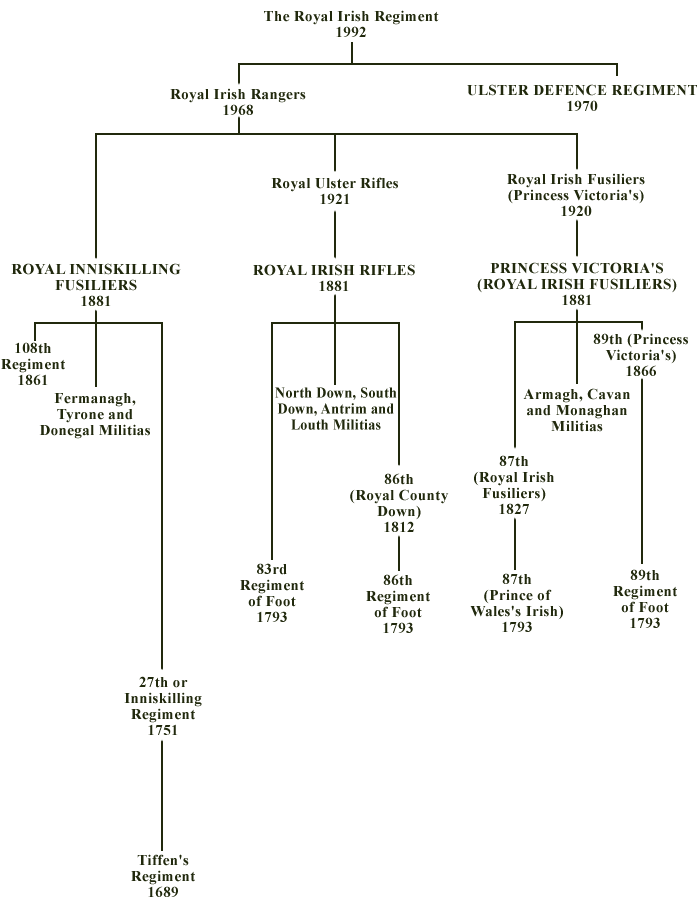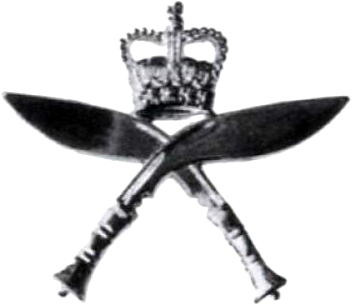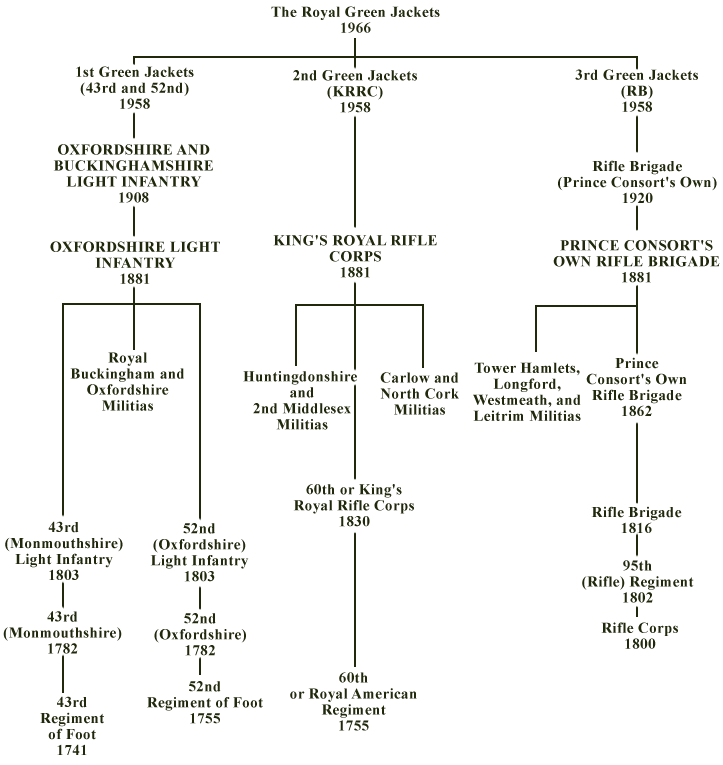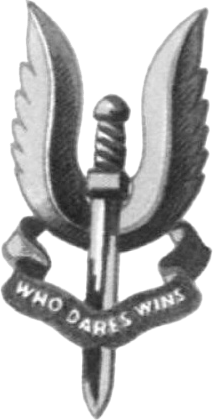
P.D. GRIFFIN
ENCYCLOPEDIA OF MODERN BRITISH ARMY REGIMENTS
General service battalions continue to wear the Rangers' green caubeen with its green hackle, while the home service battalions keep to the green beret of the UDR, but the Angel harp and crown badge is worn throughout the regiment. The Fusiliers wore blue caubeens from around 1945, though their pipers had them in the 1920s, but the green caubeen and hackle, with the harp and crown badge, came from the Royal Ulster Rifles.
The collar badge, an Inniskilling scroll and castle with St George's flag flying from the battlements, came from the Royal Inniskilling Fusiliers. It commemorates the siege of Enniskillen in 1689, when the regiment was formed out of the town's Protestant defenders.
The general service battalions wear Rangers uniforms, which are based on those of the Royal Ulster Rifles: green No. 1 dress with the caubeen, black belt and buttons. Officers wear the Rifles' black leather pouch belt with a whistle and chain hanging from a shamrock boss, the pouch mounted with the Barrosa eagle of the former Royal Irish Fusiliers. This marks the capture of the imperial eagle of the French 8th Regiment by Sgt Masterson of the 87th at the Battle of Barrosa in 1811, when the Prince Regent showed his pleasure by conferring the eagle emblem on the regiment's insignia.
Green No. 1 dress with bright buttons is issued to the mascot handler, buglers, pipers and drummers. The pipers' version meets with a design First seen in the Royal
Irish Fusiliers around 1922: a green doublet with white edging tape and buttonhole loops, traditional saffron kilt, a black patent leather purse and green cloak chained across to a Celtic Tara brooch. Pipers of the Inniskillings wore grey jackets, acknowledging the grey coats worn by Tiffen's Regiment in 1689.
Mess jackets are scarlet with green facings, a reminder of the redcoat fusiliers.
The regimental quick march, Killaloe, was written around 1887 and is punctuated by veils from the ranks. The Irish Fusiliers' war cry Faugh a Ballagh! (Clear the way!) is now the regimental motto.
The slow march, Eileen Alannagh, was adopted in 1972. Regimental marches played prior to amalgamation, and now on suitable occasions, are Sprig o' Shellalagh and Rory o' More (Royal Inniskilling Fusiliers), Off, Off Said the Stranger, adopted by the 83rd around 1879 (Royal Ulster Rifles) and, from the Royal Irish Fusiliers, St Patrick's Day, Garryowen, Barrosa and Norah Creina.
Vesting, or Rangers' Day (1 July) commemorates the 1968 amalgamation, the 1881 amalgamations, and the day in 1916 when eighteen battalions of the Northern Irish Division fought in the opening Battle of the Somme.
Shamrock is worn on Paddy's Day', a custom of the old Irish regiments now lost to most natives of the Emerald Isle.

On Barrosa Day (5 March) the Rangers maintained a mess custom in which brandy, whiskey, curacao and sherry were mixed together in the Barrosa Cup to celebrate an unfortunate direct hit on the liquor wagon, which resulted in a sudden drop in the 87th's drinks ration. A sad poem sting by officers at the anniversary dinner recounted the battle's events, and a speech made by the newest subaltern related the story and order of battle.

Pipers of the Royal Irish Fusiliers in Tripoli, 1959. (Regiment)
On Waterloo Day (18 June) regimental custom dictates that officers fall in on parade and then fall out again to allow the sergeants command of their companies. This practice highlights the officer casualties of the 27th (Inniskilling) Regiment at the Battle of Waterloo.
A succession of Irish Wolfhound mascots has been maintained since 1971, all endowed with the name of the ancient Irish chieftain, Brian Boru.

Volunteers for parachute training were recruited during the early years of the Second World War, though parachute trials for military use had been pioneered by the Italians in 1927, the Russians in 1930 and the Germans in 1936. Parachute battalions formed in 1942 were put together as a regiment seven years later.
In 1950 King George VI presented colours to each battalion with the motto Utrinque paratus (Ready for anything) embroidered on. The Parachute Regiment recruited in its own right from 1952 from its base at Browning Barracks in Aldershot. Regimental headquarters are now located in the Colchester Garrison.
The maroon beret, which has been used to distinguish all airborne units since 1942, is worn by all personnel in most orders of dress. The regimental badge, a spread of wings with an open parachute and royal crest thereon, is worn on the beret, parade uniform collars, belts and buttons. Uniforms conform to standard infantry pattern except for the smock, which is designed for parachuting.
All trained members wear a wings emblem at the top of the sleeve to show they have passed through training and made the required number of jumps, one of which is made at night.
Stable belts and distinguishing stripes on No. 1 dress 'blues' are maroon, though lanyards are worn to battalion colours.
The inspiring quick march Ride of the Valkyries was arranged for the regiment in 1950 from Wagner's Die Walkurie, which retold the Norse legend of Odin's Valkyrja, the 'Choosers of the slain' who rode through the sky to the battle.

Paras on Salisbury Plain on 16 Air Assault Brigade's exercise, 2003. (MoD)
A shortened version of Elgar's Pomp and Circumstance March No. 4 is the regimental slow march.
The three battalion bands formed in 1947-8 were amalgamated into one prior to the restructure of army bands in 1994.
Paras' are short on regimental history but unsurpassed in regimental pride. Recruits learn about early operations at Bruneval, Normandy and Arnhem, as well as the more recent Falkland Islands conflict, while undergoing infantry training, which extends to P Company, the harsh pre-parachute selection test devised in the 1940s to produce soldiers that will be equal to the particular dangers faced by the paratrooper.
Para training looks for courage, peak physical Fitness and a self-reliance that is unmatched by any other unit outside the airborne brotherhood. Soldiers who survive P Company are packed off to the RAF and Parachute Training School (motto Knowledge dispels fear) to qualify in their chosen role for the 'Maroon Machine'.
On Airborne Forces Day, veterans of the Parachute Regimental Association gather together. Individual battle anniversaries used to be observed within the battalions but representatives of the regiment are still sent to events on the Continent that commemorate wartime operations at the battle sites.
In 1955 the first of the regiment's Shetland pony mascots was adopted: Pegasus in 1 Para, Bruneval in 2 Para and Coed Goch Samswn in 3 Para.

The Gurkha Brigade is the collective term for the various Gurkha battalions and units that have been integrated into the British Army since four regiments of Gurkha Rifles (the 2nd, 6th, 7th and 10th) were transferred from the Indian Army after Indian independence in 1947.
Gurkhas come from the mountainous principality of Ghorka in Nepal. Their long relationship with the British Army began in northern India in 1813, when their warlike expansion into neighbouring lands clashed with British interests and a determined conflict ensued in which both sides grew to admire the other's bravery.
The army finally accepted the Gurkhas' offer of help in the Indian Mutiny and has sustained the bond ever since.
Brigade headquarters are at the airfield camp near Netheravon in Wiltshire.
The black Kilmarnock cap, adopted around 1860, is worn with No. l dress; the Kashmiri, a stiff-brimmed hat based on the slouch hat worn from 1901 in hot climes, is reserved for service dress. In working dress the beret is worn, green for the Royal Gurkha Rifles and blue for the support regiments.
Badges are designed around the Gurkhas' heavy knife that is carried on the back of the belt on all orders of dress. The kukri is a close combat weapon with a curved blade which broadens to a point. The badge of the Royal Gurkha Rifles (RGR) and the brigade band has two crossed kukris with a crown above. The Queen's Gurkha Engineers' kukris are embellished with the RE grenade and motto within the RE crowned wreath, the Queen's Gurkha Signals' kukris lie between the Royal Signals' figure of Mercury and the motto, and the Queen's Own Gurkha Logistic Regiment wear the star of the Royal Logistic Corps badge with the crossed kukris thereon. On the Kashmiri, RGR wear their badge pinned to a patch of Hunting Stuart tartan, a distinction of 10GR worn to mark their affiliation to the Royal Scots.
No. 1 dress is rifle green in the RGR and the band, and blue in the support regiments. 'Blues' are distinguished by trouser stripes that correspond to those on the uniforms of the associated corps, Royal Engineers, Royal Signals or Royal Logistic Corps.

Subaltern in RGR No. 1 dress with the Queen's Truncheon in 2000. Note the Royal Green Jackets' badge on his black belt. (Grenadier Publishing)
RGR uniform collars are underlined with scarlet piping, a peculiarity of 2GR worn to signify its special relationship with the King's Royal Rifle Corps, whose green jackets were regimentally coloured with scarlet facings. Belts and buttons conform to the Rifles' black pattern. The waist belt is worn over a black cummerbund in service dress. The black pouch belt, worn by officers across the shoulder, is ornamented with the badges of affiliated regiments: the Royal Green Jackets' on the front and the King's Royal Hussars' on the back pouch. The silver ram's head, from which hangs the whistle chain, commemorates the Sirmoor Battalion's assault on Fort Koonja in 1824.

Gurkha pipers date from the old days of Empire when Indian Army units liked to emulate the sounds of Scottish regiments stationed in India. Their uniforms are identified by tartans: McLecce in the Queen's Gurkha Engineers, Red Grant in the Queen's Gurkha Signals and McDuff in the Queen's Own Gurkha Logistic Regiment. Pipers of the Royal Gurkha Rifles wear the Douglas tartan of the Cameronians (Scottish Rifles), a legacy of tiieir affiliated regiment the 7GR, whose uniform was marked out by Douglas tartan trews.

Recruits at the brigade depot (Malay Lines) in No. 6 warm weather dress
The Brigade quick march is Yo Nepali. The Rifles march to The Bravest of the Brave in quick time, The Keel Row in double time and God Bless the Prince of Wales in slow time. The slow march came from 2GR and relates to its 1876-1906 title. The RGR pipers' march is the traditional Scottish Garb of Old Gaul.
The Gurkha Band was made by merging the 2GR band, formed in 1859, with the Staff Band of the Brigade of Gurkhas, formed in 1958.

7th Gurkha Rifles sharpening kukris for the Falklands War, 1982
The great respect with which Gurkhas are held in the army is generated by their conduct, efficiency and bravery, qualities that are underpinned by the RGR motto Kafar hunnu bhanda marnu ramro (It is better to the than be a coward).
No colours are carried in the brigade but the Rifles march behind their Queen's Truncheon, which was ordered to 2GR by Queen Victoria when it became a rifle regiment after the Indian Mutiny. As a rifle regiment, the 2nd had to lay up its colours, one of which was an honorary colour awarded for its bravery at Delhi, where the regiment formed an undying association with the 60th Rifles. The truncheon dismantles into five pieces to facilitate it being carried into battle by five soldiers. The crown is supported by three Gurkha figures on a ring of silver inscribed MAIN PICQUET, HINDOO RAO'S HOUSE, DELHI 1857. On a lower ring the inscription is repeated in Nagri script. In 2GR the men called the truncheon Nishani Mai (the Great Mother) and swore their oath of allegiance on it when joining the regiment. On anniversaries like Delhi Day (14 September) and the crossing of the Tigris in 1917, the truncheon would be put out for saluting.

The Royal Green Jackets (RGJ) was formed in 1966 when the three battalions of the Green Jackets Brigade were brought together as a regiment. The brigade had been formed in 1958 from the regiments first trained in light infantry tactics - the Oxfordshire and Buckinghamshire Light Infantry (OBLI), the Kings Royal Rifle Corps (KRRC) and the Rifle Brigade.
The royal title came from the old 60th, styled the Royal American Regiment in 1757. The regiment was raised in Pennsylvania two years earlier under a bill that allowed the King the right to grant commissions to foreign Protestants for military service in the Americas. Almost 200 years later, during the Second World War, the KRRC got special permission to train a cadre of .Americans as officers in the regiment.
The term 'Green Jackets' was first applied to the experimental rifle battalions created at the end of the eighteenth century to operate in open skirmish order with the deadly Baker rifle. The first had a high proportion of German light troops and dressed its riflemen in the green jackets worn by German hunters and woodsmen, a distinction copied by successive rifle battalions. The concept prospered and riflemen became the subject of popular legend.
Regimental headquarters are at Peninsula Barracks in Winchester, the shared depot of the KRRC and the Rifle Brigade from 1858. Peninsula recalls the war in which the four original regiments successfully employed the specialist light infantry movements taught by Sir John Moore, the pioneer of the famous Light Division.

An officer of the 95th Rifles re-enactment group with light infantry in the background in uniforms of the Napoleonic Wars
Caps and berets are rifle green, the colour of Rifles and Light Infantry headgear since the late Victorian era. The cap badge is based on that of the Rifle Brigade, a Maltese cross inscribed with battle honours within a crowned laurel wreath and naval crown marked COPENHAGEN 2ND APRIL 1801. An inscribed Maltese cross without a wreath, which formed the badge of the KRRC, originated on officers' pouch belts in the 5th Battalion of the 60th Rifles, raised in 1797 - the first of the regiments Green Jackets. The cross is thought to have come from a German officer of the battalion (Hompesch), who was a Knight of Malta. The strung bugle horn at the centre of the cross, worn by all light infantry and rifle regiments, now appears on the front of the green side hat worn by RGJ officers.

Bugler of 1RGJ, c. 2002. (MoD)
No. 2 dress is worn with the green cap, the jacket distinguished with the Rifles' black belt and buttons, and a small, blackened bugle horn collar badge.
No. 1 dress and mess dress 'greens' have no collar badge - a regimental tradition. Officers' tunics of 'Ox and Bucks' vintage have a button and length of braid sewn onto the collar, a unique distinction of the Oxfords' officers, who wore it as a relic of the eighteenth-century gorget which used to hang from buttons on the collar. Buglers wear gold-laced shoulder wings on the tunic and the plumed busby that was peculiar to rifle regiments from 1890. The bugle major is equipped with a traditional Rifles officers' braided tunic and the black pouch belt that goes with it. The regimental nickname, 'Black Mafia', stems from this dark order of dress and the regiment's well-connected officers.

The regimental march is made up of Huntsman's Chorus from the KRRC and The Italian Song adopted by 4th Battalion of the Oxfordshire and Buckinghamshire on campaign in Italy in 1943. Weber's Huntsman's Chorus (previously Lutzows Wild Chase) speaks of the German Jagers who went to fill the ranks of the 60th Rifles' 5th Battalion in 1797 and Lutzow's German riflemen who fought against Napoleon in the ensuing wars.

Riflemen operating the pairs system in the field, 1997. (Grenadier Publishing)
The RGJ uphold the fast marching pace of their antecedent regiments and chose The Road to the Isles for their double past. Other regimental marches are Nach Flager Von Grenada (43rd) and The Lower Castle Yard (52nd) of the Ox and Bucks, and I'm Ninety Five of the Rifle Brigade, which held that number in the line before changing to brigade status.
Regimental anniversaries concern birth dates and battle days, mostly inherited; 1 January celebrates the formation of the Royal Green Jackets in 1966, but the regimental day is 25 July. In July 1968 battalion subtitles were abolished and a 'one regiment' spirit was encouraged.
The date 17 January marks the birth of the 43rd Regiment in 1741, 20 December the 52nd in 1755 and 25 December the 60th Regiment, also in 1755; 25 August commemorates the day in 1800 when the Rifle Corps first saw action, at Ferrol on the Spanish coast; 11 November remembers the KRRC at the Battle of Nonne Bosschen in 1914; 28 February the Relief of Ladysmith in 1900, which involved the KRRC and the RB; and 18 June the 52nd's defeat of the Chasseurs de la Garde at Waterloo, an important day in the Oxfordshires.
The date 14 September (Delhi Day) commemorates the struggle of the 52nd and the 60th against the Indian mutineers during the siege of 1857, and the start of the KRRCs' enduring friendship with 2nd Gurkha Rifles.
Membership of the Wolfe Society is inherited from the OBLI and the KRRC. At the Battle of Quebec in 1759 Gen Wolfe described the 60th as 'Swift and Bold', an acclamation the regiment later turned into a motto (Celer et Audax) and its ethos.
Green Jackets' drill has long differed from accepted army practice. The normal marching pace of 120 to the minute is upped to 140-180 per minute at the double, a reminder of the Napoleonic Wars when riflemen were trained to run ahead of the main body to skirmish with the enemy. This rapid deployment over wide areas of rough terrain meant that the Green Jackets had to be able to travel light, without the usual paraphernalia carried by the redcoats. Colours and drums, therefore, were dismissed from Green Jacket tradition and bugles replaced drums to convey orders across the battlefield. Today, buglers are seen in the RGJ where drummers are normally employed in other regiments. Rifles are traditionally carried down 'at the trail' with a loose sling, a throwback to days wrhen light infantrymen had to march ready to give fire. Bayonets are referred to as swords because swords used to be issued instead of bayonets to extend the short Baker rifle to normal length. Emphasis is still placed on the Rifle regiments' old philosophy of discipline through encouragement and initiative.

THE SPECIAL AIR SERVICE REGIMENT
The Special Air Service Regiment (SAS) grew out of commando units formed in North Africa during the Second World War for raids behind enemy lines. Maj David Stirling of No. 8 Commando, who initiated parachute training for airborne attacks on German installations in the desert, was given command of the first special service regiment in 1942. After Stirling's capture in January 1943 a second 'special' regiment was created with his brother at its head. The word Special describes the units' departure from conventional tactics.
After the war SAS and commando units were disbanded but in 1947 the former was reconstituted in a TA battalion when the Artists Rifles, a London volunteer unit raised in 1860, was transferred from the Rifle Brigade as 21SAS. During the Malayan emergency a need was identified for a special force that could survive in the jungle. Former Chindits and SAS soldiers were recruited to form the Malayan Scouts (SAS), which was admitted to the army list in 1952 as the Special Air Service. The regiment has been based at Hereford since 1960.

Maj David Stirling with his Long Range Desert Group in North Africa, 1942. (Imperial War Museum)
The beige beret and the winged dagger badge (with its motto Who Dares Wins) originated with Stirling and his men in 1942. The dagger symbolises the weapon used by commandos when operating by stealth, although it is officially described as a representation of Excalibur striking downwards.
The secretive nature of the regiment's work requires special clothing and kit, most famously black combats and balaclavas. Badges of rank are not worn on operational duties. The stable belt is blue.
No. 1 dress 'blues' are distinguished by a Pompadour (light blue) stripe on trousers and overalls. The CO and Officer of the Day traditionally wear a black leather pouch belt mounted with a silver whistle chain and the Mars and Minerva badge of the Artists Rifles.
The Marche du Regiment Parachutist Beige (quick) and Li Hie Marlene (slow), are both reminiscent of the Second World War, when the regiment first made its mark on the world. The quick march refers to the year 1944 when the SAS Brigade embraced Belgian and Free French parachute squadrons.
We have much more interesting information on this site.
Click MENU to check it out!
∎ cartalana.com© 2009-2025 ∎ mailto: cartalana@cartalana.com